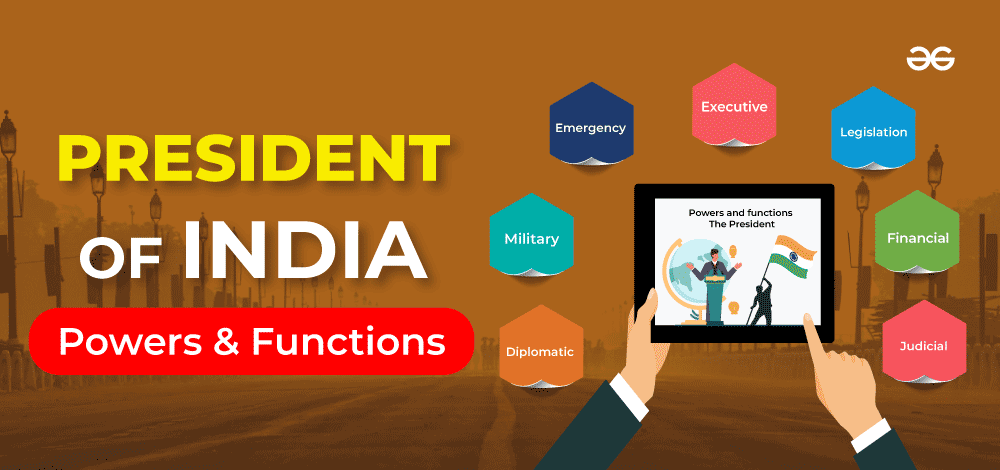The President of India is the ceremonial head of state, a figure who embodies the unity and integrity of the country. As the highest office in the nation, the President holds significant constitutional powers and duties, although in practice, many of these are exercised by the Prime Minister and the Cabinet. The role is largely symbolic, but the position carries immense respect and serves as the cornerstone of India’s democracy.
The Role and Powers of the President
The President of India is described in the Constitution as the first citizen of the country. They act as the constitutional head of state, representing the country in international forums and performing important functions within the framework of the Indian Constitution.
While the President holds considerable authority, most of this power is exercised on the advice of the Council of Ministers led by the Prime Minister. This system ensures that executive decisions are made by the elected government, not the President. Despite this, the President’s role is vital in maintaining the balance of power between the legislative, executive, and judicial branches.
Here are some of the key functions and powers vested in the office:
1. Executive Powers
The President is the supreme executive authority in India, but the real power lies with the Cabinet, which is headed by the Prime Minister. The President appoints the Prime Minister and other members of the Cabinet, and they also appoint Governors for states, Judges of the Supreme Court and High Courts, and key officials like the Comptroller and Auditor General, the Chief Election Commissioner, and the Chief of the Armed Forces.
The President also plays a role in the formation of a new government after general elections. If no single party wins an absolute majority, the President has the discretion to invite the leader of the largest party or coalition to form a government.
2. Legislative Powers
The President is an integral part of the Indian Parliament, but their role is largely formal. The President can summon, prorogue, and dissolve the Lok Sabha (the lower house of Parliament), and give assent to bills passed by Parliament, which is necessary for them to become law.
Additionally, the President can promulgate ordinances when the Parliament is not in session. These ordinances have the same effect as laws passed by Parliament, but they must be ratified within six weeks of Parliament reconvening.
3. Judicial Powers
The President has the power to grant pardons, reprieves, respites, or remissions of punishment, or to suspend, remit, or commute sentences in certain cases. This includes cases where the punishment is related to a matter of law involving the death penalty.
4. Military Powers
As the Supreme Commander of the Indian Armed Forces, the President holds the title of head of India’s military, though military decisions are made by the Cabinet. The President appoints the Chiefs of the Army, Navy, and Air Force, and plays a role in the declaration of war and peace treaties, again, acting on the advice of the government.
5. Emergency Powers
The President has the authority to declare three types of emergencies under the Constitution:
- National Emergency: If the security of India or any part of it is threatened by war, external aggression, or armed rebellion.
- State Emergency (President’s Rule): If a state government cannot function according to the provisions of the Constitution.
- Financial Emergency: If the financial stability or credit of India or any part of it is threatened.
These powers allow the President to take swift action in times of crisis, although in practice, they are exercised on the advice of the Prime Minister and the Cabinet.
The Election of the President
The President of India is elected through an indirect election process, where Members of Parliament (MPs) and elected representatives from the state legislatures (MLAs) vote in a proportional representation system by single transferable vote. This ensures that the election process is balanced, reflecting both the population and political weight of states.
The term of office for the President is five years, but they can be re-elected for subsequent terms. If the President resigns, dies, or is otherwise unable to continue in office, the Vice President of India assumes the duties of the President until a new election is held.
The First President of India
The first President of India was Dr. Rajendra Prasad, who served two terms from 1950 to 1962. Dr. Prasad remains the only President to have been elected to two consecutive terms. His presidency marked the early years of independent India and set the foundation for the office of the President in the country’s parliamentary democracy.
Current President of India
As of 2024, the current President of India is Droupadi Murmu, who assumed office on July 25, 2022. She made history as the first tribal woman to hold the highest constitutional post in the country, representing a significant milestone in India’s political and social landscape. Her election is seen as a reflection of the growing representation of marginalized communities in India’s governance structures.
Conclusion
The President of India is a position of great importance, even if its role is largely symbolic and ceremonial in nature. As the head of state, the President upholds the Constitution, represents national unity, and ensures the smooth functioning of the country’s democratic processes. While the powers of the President are exercised in collaboration with the government, the office remains central to India’s political framework and governance system, embodying the nation’s values and traditions.
